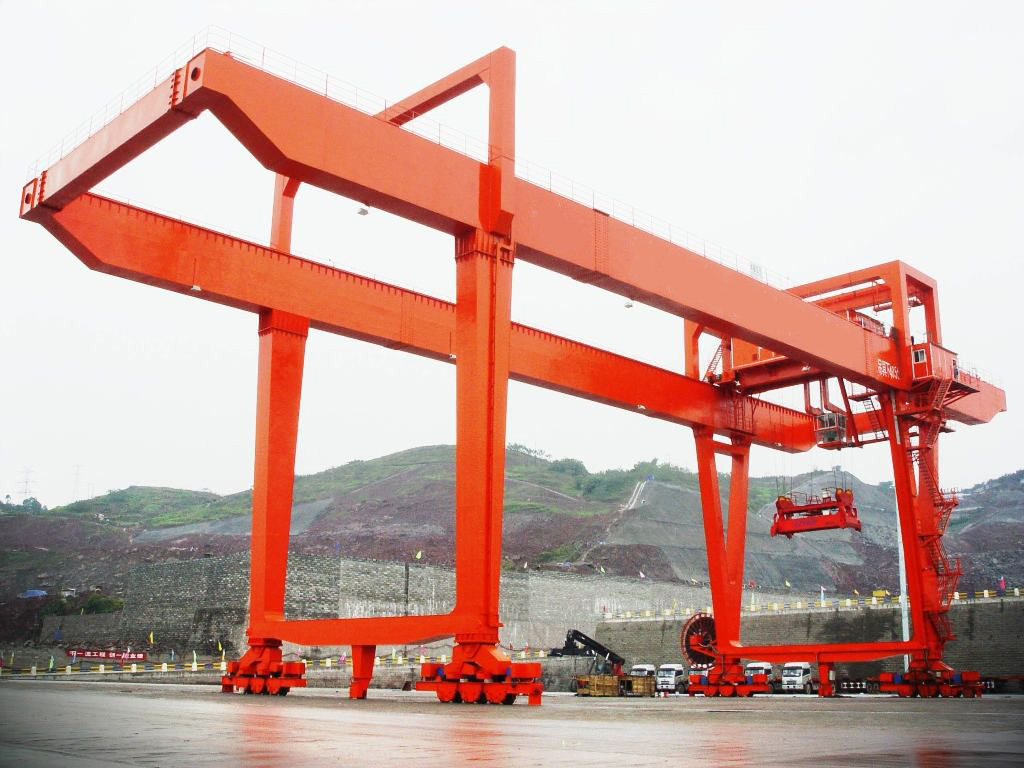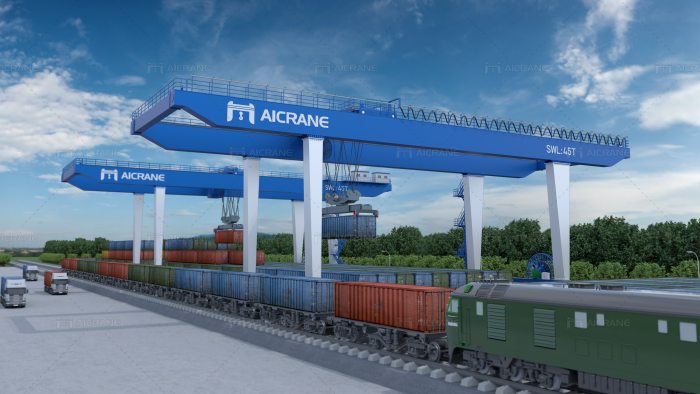Rail-mounted container gantry cranes (RMG) have revolutionized the container handling process in rail yards and intermodal terminals. These large-scale cranes are specifically designed to handle containers with precision and efficiency. By utilizing a rail-mounted system, RMG cranes provide seamless movement along the tracks, enabling the quick and accurate positioning of containers. This article explores the main components of RMG cranes, their applications, operation, and regular maintenance practices.

Main Components of Rail-Mounted Container Gantry Cranes
RMG cranes consist of several essential components that work together to facilitate efficient container handling:
Gantry Frame: The gantry frame forms the main structure of the crane, supporting the entire weight and providing stability during operations. It spans across the rail tracks and houses the trolley system and hoist mechanism.
Rail Wheels: Rail wheels are mounted on the underside of the gantry frame, allowing the crane to move along the tracks. These wheels are designed to provide smooth and precise movement, ensuring accurate positioning of the crane during container handling.
Trolley System: The trolley system runs along the gantry frame and carries the hoist mechanism. It allows the horizontal movement of the hoist and container spreader, enabling precise loading and unloading operations.
Hoist Mechanism: The hoist mechanism is responsible for lifting and lowering containers. It is equipped with a powerful motor, wire ropes, and a container spreader. The hoist mechanism enables smooth and controlled vertical movement of containers during handling.

Main Applications of Rail-Mounted Container Gantry Cranes
RMG cranes find extensive applications in rail yards and intermodal terminals for efficient container handling:
Intermodal Terminals: RMG cranes are widely used in intermodal terminals, where containers are transferred between different modes of transportation, such as trains, trucks, and ships. These cranes facilitate the quick and accurate transfer of containers between railcars and trucks, ensuring efficient cargo flow.
Rail Yards: Rail-mounted container gantry cranes play a crucial role in rail yards, where containers are sorted, stored, and loaded onto trains. These cranes efficiently stack and retrieve containers, optimizing space utilization and expediting the loading process.
Container Depots: RMG cranes are employed in container depots for container storage and maintenance. They facilitate the movement and stacking of containers, allowing for organized storage and easy access when needed.
Operation of Rail-Mounted Container Gantry Cranes
The operation of RMG cranes requires skilled personnel who are trained in crane operation and safety protocols. The key steps involved in operating an RMG crane are as follows:
Pre-Operational Checks: Before commencing operations, the crane operator performs pre-operational checks to ensure that all components are in proper working condition. This includes inspecting the crane’s structure, rail wheels, hoist mechanism, and safety devices.
Container Positioning: The RMG crane operator positions the crane over the designated container for lifting. The hoist mechanism is carefully lowered onto the container, and the container spreader securely attaches to the container.
Container Handling: The hoist mechanism lifts the container off the ground, and the trolley system allows for horizontal movement. The operator carefully moves the container to the desired location, either for loading onto a train or for storage in the yard.
Safety Considerations: During operation, the RMG crane operator must adhere to all safety protocols and regulations. This includes maintaining safe distances from other cranes and obstacles, avoiding excessive speeds, and adhering to load limits to prevent overloading.
Regular Maintenance of Rail-Mounted Container Gantry Cranes
Regular maintenance is essential to ensure the safe and efficient operation of RMG cranes. Here are key maintenance practices to consider:
Routine Inspections: Conduct regular inspections of the crane’s components, including the gantry frame, rail wheels, hoist mechanism, wire ropes, and safety devices. Inspections help identify any signs of wear, damage, or malfunction that may compromise the crane’s performance or safety.
Lubrication: Proper lubrication of moving parts, such as rail wheels, hoist mechanism, and trolley system, is crucial to reduce friction and ensure smooth operation. Follow the manufacturer’s recommendations for lubrication intervals and use the appropriate lubricants.
Wire Rope Inspection and Replacement: Regularly inspect wire ropes for signs of wear, corrosion, or deformation. Replace worn or damaged wire ropes promptly to maintain safe and reliable lifting operations.
Electrical System Maintenance: Inspect and test the electrical components of the RMG crane, including motors, switches, and control systems. Ensure that electrical connections are secure and free from corrosion.
Operator Training: Continuously provide training to crane operators to ensure they are familiar with proper operating procedures, safety protocols, and emergency response measures. Regular training updates enhance their skills and promote safe operation.
Rail-mounted container gantry cranes offer efficient and precise container handling solutions in rail yards and intermodal terminals. With their robust structure, rail-mounted system, and hoist mechanism, these cranes facilitate seamless movement and accurate positioning of containers. Regular maintenance practices, routine inspections, and proper operator training are vital to ensuring the safe and reliable operation of RMG cranes. As container traffic continues to grow, rail-mounted container gantry cranes will remain instrumental in optimizing container handling operations and supporting the global logistics industry.